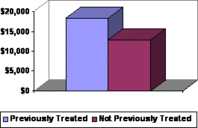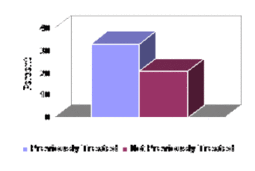Numerous studies have estimated expenditure and debt related to problem gambling (National Opinion Research Center, 1999; Productivity Commission, 1999; Volberg, Gerstein, Christiansen, & Baldridge, 2001). Such studies frequently examine the financial status of problem gamblers irrespective of important factors that could influence the accumulation of debt such as gender, time at risk, game preferences, and socio-economic status. This week’s WAGER examines the influence of a previous gambling treatment history on the gambling debt of participants in Iowa Gambling Treatment Program (Shaffer, LaBrie, LaPlante, & Kidman, 2002).
The Iowa Gambling Treatment Program (IGTP) is a network of treatment facilities under the direction of the Iowa Department of Public Health. The program provides crisis services, counseling and continuing care to the entire community, including problem gamblers, family members, and other concerned persons. During the first phase of this ongoing program evaluation, from July 1997-June 2001, contracted treatment facilities collected demographic, background and financial information on a cohort of gambling treatment seekers (N=2,356). Problem gamblers (PG) included, but were not limited to, those satisfying the DSM-IV diagnostic criteria for pathological gambling. The Harvard Medical School’s Division on Addictions analyzed this data.
On average, at the time of their first admission to the IGTP, problem gamblers wagered $522 a week and accumulated $34,639 in total debt; of this $14,084 was attributable to gambling. Median values for weekly wagers ($300) and gambling debt ($4,060) indicate that a few individuals who amassed very large gambling related debt had a disproportionate impact on the debt averages. Almost one quarter of problem gamblers (23.7%) reported that they had declared bankruptcy. Interestingly, gamblers who had a previous history of gambling treatment (N= 480) had significantly more gambling-related debt than gamblers entering treatment for the first time (Figure 1). These individuals also were more likely to have declared bankruptcy (Figure 2). Although they evidenced more severe problems on cumulative measures of debt and bankruptcy, problem gamblers who reported previous treatment were not wagering significantly more on a weekly basis than other problem gamblers at admission.
Figure 1. Gambling Debt by Treatment History Group
Figure 2. Bankruptcy by Treatment History Group
It is important to note that this study design precludes causal inference. Consequently, the root of financial differences between those who did and did not receive previous treatment is unknown. For example, do financial problems stimulate more treatment episodes or do the observed findings merely reflect the natural course of treatment? Similarly, higher rates of bankruptcy might be a result of financial counseling associated with the previous gambling treatment; declaring bankruptcy might reflect sound fiscal advice. Alternatively, previous treatment might lead problem gamblers to estimate their gambling debt differently; problem gamblers seeking help for the first time might not directly attribute some debts to their gambling behaviors and thus not report them as such. In addition, the accuracy of self-reported data might be subject to conscious as well as unconscious variations. Financial information is sensitive and is often misreported to reflect socially acceptable levels. The burden of social acceptability might be minimized for previously treated individuals: they might be more honest about the extent of their gambling debt. External reviews are necessary to corroborate the self-reported data and ensure the above factors are not affecting the outcome. When making inferences about problem gamblers in general, it is important to remember that the above data was collected from people entering treatment and they may represent the most severely affected problem gamblers. A further caution relates to the limited geographic scope; the range of gambling debt may vary regionally and Iowa may not be representative of a national average.
Although this research prompts many complex questions, it is an important step towards understanding the financial facets of problem gambling. Problem gambling usually manifests itself outwardly in adverse economic consequences. These difficulties can underlie many of the other commonly sited problems, such as family conflict, crime, and suicide ideation. Understanding factors associated with financial status would inform both treatment and public policy. At the individual level, treatment providers and financial counselors might want to consider the influence of treatment history when performing an assessment of the extent of the problem. At the community level, considering treatment history may improve estimates of the proportion of gambling revenues derived from problem gamblers and inform policy makers about the balance of gambling costs and benefits.
Comments on this article can be addressed to Rachel Kidman.
References
National Opinion Research Center. (1999). Gambling impact and behavior study. Chicago: University of Chicago.
Productivity Commission. (1999). Australia’s Gambling Industries: Final Report (10). Canberra: AusInfo.
Shaffer, H. J., LaBrie, R. A., LaPlante, D. A., & Kidman, R. C. (2002). The Iowa Department of Public Health Gambling Treatment Services: Four Years of Evidence (Technical Report #101102-200). Boston: Harvard Medical School
Volberg, R. A., Gerstein, D. R., Christiansen, E. M., & Baldridge, J. (2001). Assessing self-reported expenditures on gambling. Managerial and Decision Economics, 22, 77-96.







James January 29, 2018
Very interesting post. Thank you for sharing.